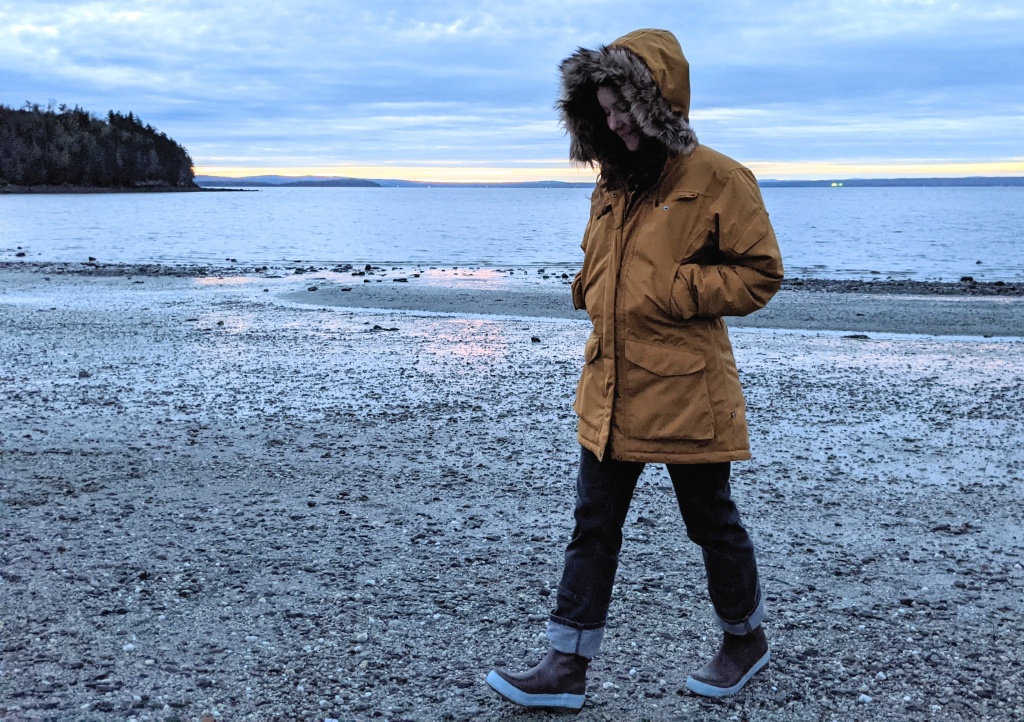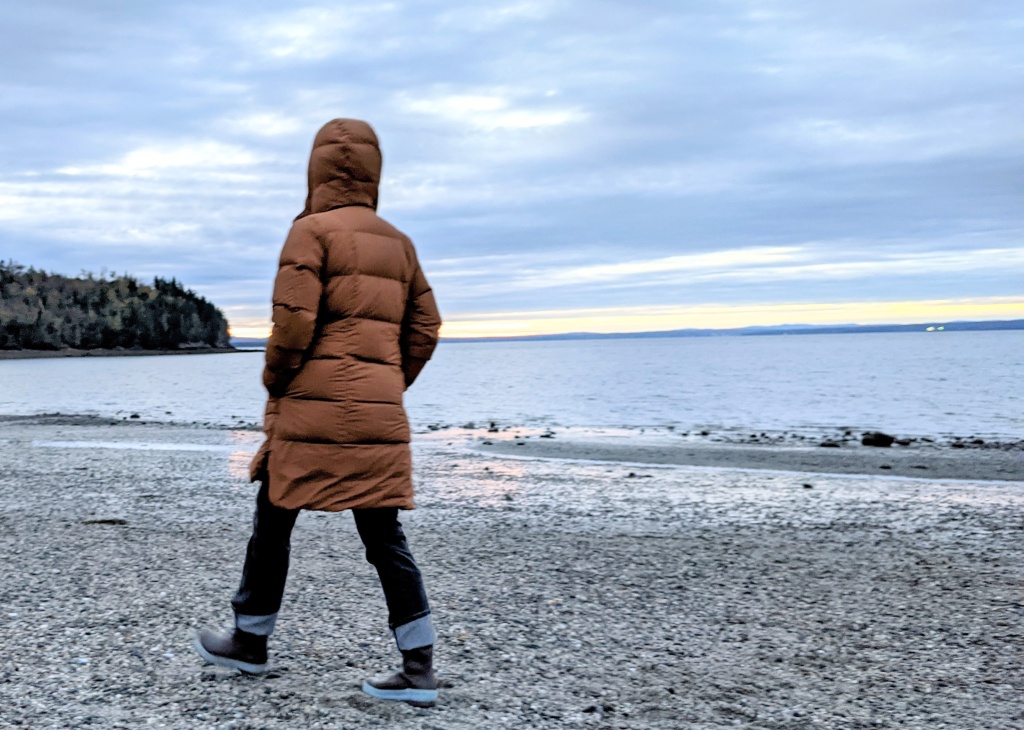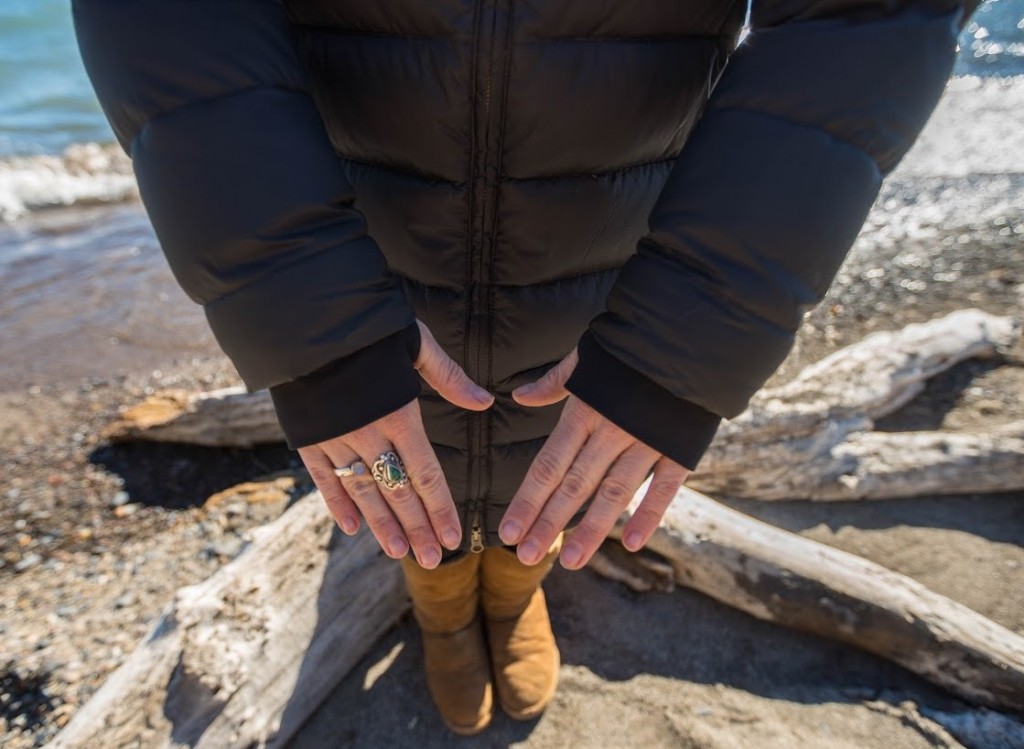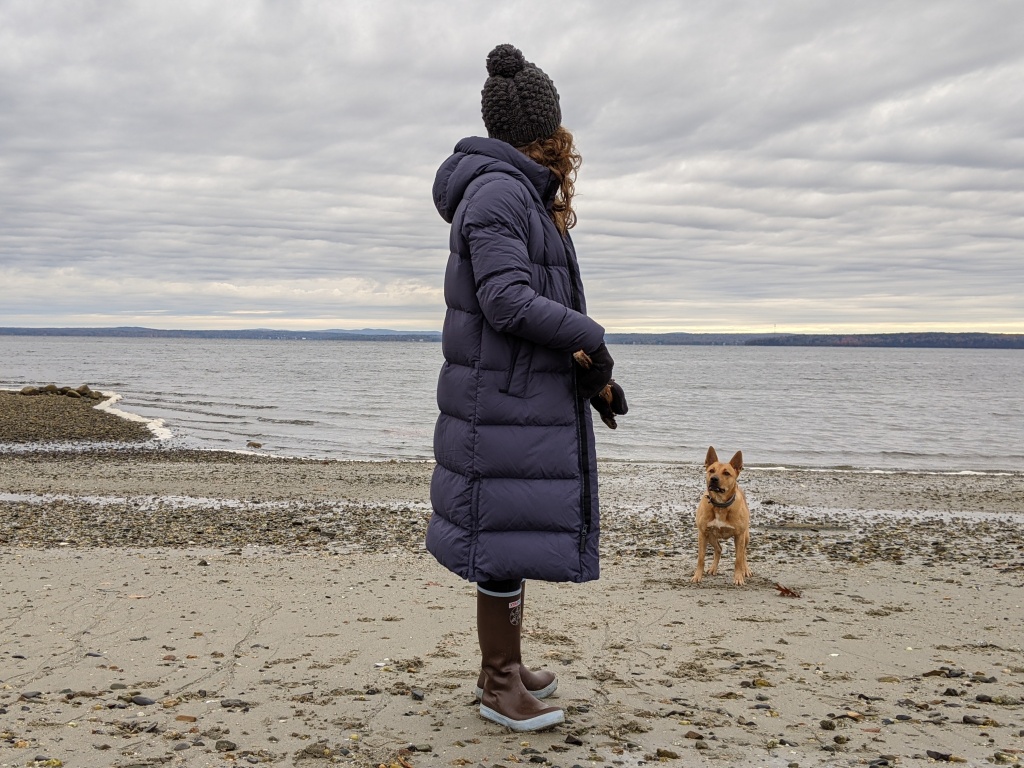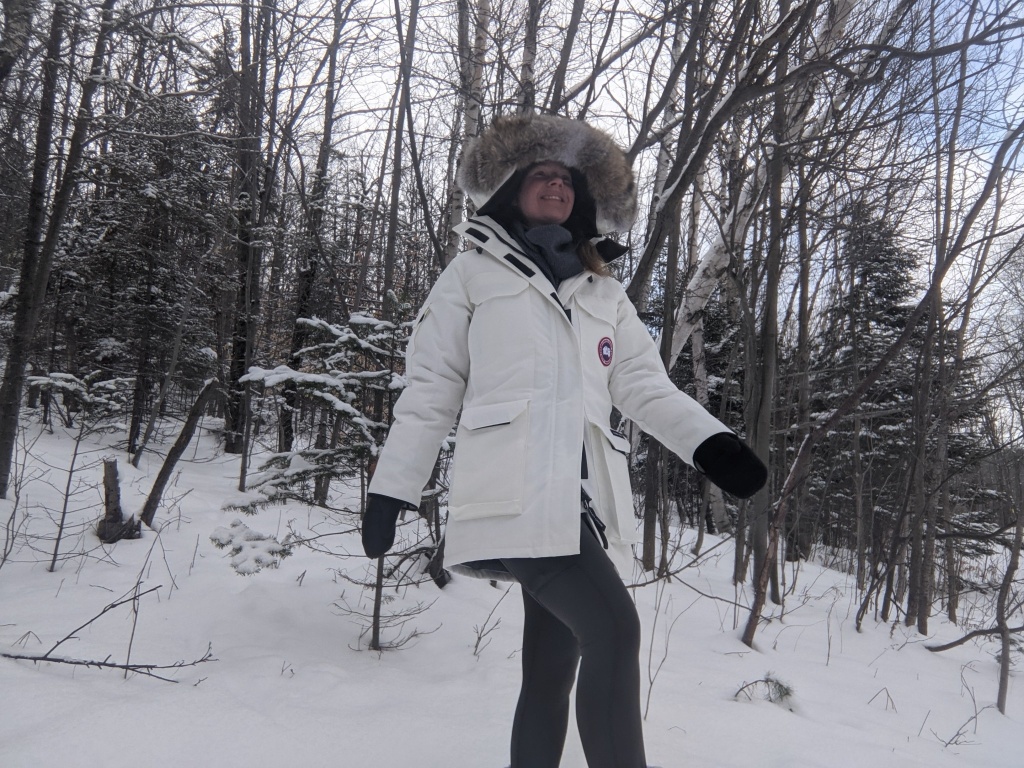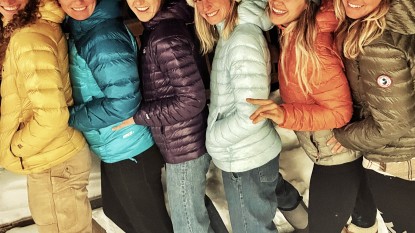The right winter jacket is the key to staying cozy in cold weather. What makes a jacket right for you depends on your climate, daily commute, and favorite wintertime activities. A casual parka with thick down encased in non-waterproof nylon will keep you warm but not dry in a wet storm. It won't be the best option if you live in the Pacific Northwest. A hardcore jacket built to keep you toasty when standing around in negative temperatures won't work for a technical ski tour or ice climbing outing. We have tested and worn more heavy winter jackets than we can count. We hope that our experience helps you make an informed decision.
Below, we break down the features and construction details to consider when choosing a winter jacket. In our women's winter jacket review, we focus on casual parkas and jackets made to keep you warm while walking, standing, or sitting in cold weather.
If you need technical layers for winter activities like running or cross-country skiing, check out our women's women's down jacket review, women's synthetic insulated jacket review, and our women's softshell jacket review. We also have a women's ski jacket review if you'll be hitting the slopes.
Insulation
Where you live and how you spend your time outside determine how much insulation you need to stay warm. If you're out chopping wood, feeding livestock, or running from the car to the office, you can get away with something lighter. If you're standing around the tailgate, waiting for the bus, or counting birds at a field station, you'll want a much warmer jacket.
Most manufacturers don't temperature-rate their jackets like they do their sleeping bags. (Canada Goose is the exception.) Look to our warmth rating chart in the review to determine which jackets work in the coldest conditions.
If you experience less than frigid winters, don't shy away from options with lower warmth scores. Many offer plenty of insulation for more temperate conditions. You can always pull an extra layer on for the coldest days, but you can't take the extra stuffing out for milder temperatures. Less insulation often makes for a more versatile coat.
Down Insulation
Down insulation is the fluffy plumage that grows beneath the outer feathers of ducks and geese. It's one of nature's great insulators. Unfortunately, harvesting it usually kills the bird. See our Sourcing Ethics discussion below for more information on this topic.
Down insulation has a high warmth-to-weight ratio. It's lightweight, highly compressible, and is an excellent way to trap your body heat in cold climates. Down's quality is measured by its loft, which is in turn measured by how many cubic inches one ounce of down fills. That's known as its fill power. One ounce of 600-fill-power down takes up 600 cubic inches, and 900-fill-power takes up 900 cubic inches.
Down traps air pockets around you, then your body heat warms them. The more space the down takes up, the more air it catches, and the warmer you stay. One ounce of 900-fill-power down will keep you warmer than one ounce of 600-fill-power down.
Higher fill-power numbers also mean that the down is more compressible. A 900-fill-power down jacket is very warm, packs down very compactly, and is very expensive. In other words, it's overkill for a casual winter coat. The jackets we test range from 500 to 800 fill-power.
Fill-power refers to the down's quality. Fill-weight refers to how much down fill there is. Say you have twice as much 600-fill-power down in one jacket as you have in a 900-fill version. The 600 coat will likely be warmer because there is more down overall. The math can get tricky, and when you add features like thicker shell fabric or fleece liners, it's hard to quantify warmth. These details are just starting points to help you figure out how warm a jacket will be.
Down does not work well if it gets wet. Water makes the down stick together, collapsing all those lovely air pockets and leaving you damp and shivering.
Pros: High warmth-to-weight ratio, compressible, lightweight, long-lasting with the proper care.Cons: Loft and warmth are jeopardized when wet, expensive, ethical and animal cruelty concerns.
Synthetic Insulation
Synthetic insulation is any human-made insulator. It's usually plastic-based, such as polyester threading and fibers that mimic the structure of down. The fibers trap warm air like down, but they don't clump or lose loft when wet.
Synthetic insulation is usually less expensive than down and doesn't require harvesting birds, but it's heavier and not as warm for its weight. It can also be bad for the environment and shed microplastics.
The most significant benefit of synthetic insulation is maintaining warmth when wet and drying out quickly. It's an excellent option for wet climates, people on a budget, or warmer temperatures.
Pros: Water-resistant, less expensive, provides insulation when wet.Cons: Heavier than down, less compressible, loses loft over time, often fossil fuel-based.
Features
Features like fleece-lined pockets and insulated hoods can make a big difference in how warm a winter jacket keeps you. Cozy cuffs are a favorite example, particularly those with thumb holes. Cinched waists that block drafts are another.
Some jackets even have unique features like internal carrying straps. These functional features can be critical to making our wintertime outside more enjoyable. Here we break down which are non-negotiable and which you can do without.
Hoods
Any self-respecting winter jacket is going to have a hood. Not only does it protect your head in stormy weather, but it also provides warmth on frigid days. Many zip or snap off for mild days or shoulder seasons.
Insulation — An insulated hood makes a big difference in below freezing temps. Hoods lined with plush down or fleece are much warmer than those that aren't. We also note how much extra room each hood has, in case you want to wear a beanie underneath.
Ruffs — A number of the tested models have fur ruffs around the hood. Most are synthetic, though some hoods are lined with real coyote fur. The use of real fur can be controversial. You can read about Canada Goose's fur and down sourcing on their website. Both natural and synthetic fur effectively trap heat around your face to protect you from the wind and cold, even from frostbite, which is why you see them on polar expedition parkas.
Many of the ruffs are removable. So if you love a particular design but not the fur, you may be able to take it off. Note that not all faux fur ruffs are created equal. Some are loftier, softer, and more effective than others. Some jackets provide deep hoods that provide nearly as much protection as a ruff with down baffles. They help, but not as much as fur does.
Pockets
We appreciate the winter jackets that feature pockets with soft fleece lining. They warm our hands up quickly. And be sure to check that there is insulation between the pockets and the outside of the coat. Many pockets aren't insulated, and we always notice.
Pockets also need to protect your valuables. No one wants to lose their keys or a brand new smartphone in a snowbank, so we prefer them to have zippers. The quality of the zippers and the size of the pull tabs make a difference when you're wearing gloves.
Two-way Zippers
Two-way zippers are more or less mandatory on any knee-length parka. Long jackets are more challenging to move around in than a mid-thigh or hip-length option. Unzipping the bottom a bit helps you walk and sit comfortably. Almost all knee-length models we tested have a two-way zipper.
Storm Flaps
We appreciate jackets with a storm flap to snap over the zipper, providing extra protection from wind and water. A bonus is that the snaps can quickly close the coat if it's not cold enough to zip it all the way up, or you're in a hurry.
Cuffs
Wrist cuffs are excellent at trapping heat and keeping precipitation out. The cuffs on the jackets we've tested are fleece, knit, elastic, or nylon. Others are adjustable via a snap or Velcro closure. Some work better than others.
Fleece cuffs are soft and warm but often dry slowly and may chill your wrists when wet. Cuffs that extend beyond the jacket sleeve are more vulnerable to wet weather.
If you live in a wet climate, or you clear mounds of snow off your car every day, you'll want a coat that has an adjustable cuff closure. Tightening the cuffs down around your wrists or gloves provides an extra layer of protection against the elements.
Shell
Very cold places tend to be dry. Frigid air doesn't have the energy to carry much moisture and, if it does, that water is frozen. Warmer winters tend to be wetter. In a wet climate, you'll want something waterproof or at least water-resistant. Whether a jacket can resist or completely seal water out depends on its construction and whether it's treated with a durable water-repellant (DWR) coating.
The jackets we reviewed have either a single-layer shell made of nylon or polyester or one with a layered construction that includes a waterproof membrane covered by a face fabric. Most have a durable water-repellant (DWR) treatment as well.
DWR Coatings
A DWR coating helps water bead up and roll off a jacket, but it doesn't make it waterproof. If it's not paired with a waterproof membrane, DWR treatments only briefly extend your time in the elements. Nylon and polyester fabrics have a low absorbency rate. When treated with a DWR finish, they can shed water well for quite a while.
DWR coatings wear off over time due to wear, tear, and washings. When that happens, you can buy aftermarket treatments to reapply at home, like ReviveX Durable Waterproofing or Nikwax. They vary in quality, and traditional coatings have been found to be quite toxic. The industry is seeking less toxic alternatives, but it's rare to find a rigorous study to prove their claims.
The majority of the winter jackets we tested come with a DWR coating. If you live in a wet winter climate, consider a jacket with a waterproof membrane to make sure you stay dry.
Waterproof Membranes
Waterproof jackets are made by layering fabrics, one of which must be a working waterproof membrane. This layer blocks rainwater or snowmelt. If the membrane is also breathable, it will release some of the heat and sweat you generate through pores, millions of them per cubic inch.
Waterproof membranes are covered by exterior face fabrics. The membrane can't breathe as well if the face fabric is saturated with rain, so they almost always have a DWR coating as well. Some jackets will include a third layer, usually an inner mesh or taffeta layer that feels soft and dry against your skin.
These are highly technical fabrics with familiar names like Gore-Tex, The North Face's “HyVent,” and Patagonia's “H2No”. They offer excellent protection from the elements in your everyday life.
An MM rating refers to how many millimeters of water can stand on a jacket for 24 hours without saturating it. Since a taller collum of water creates pressure on a membrane, this designates how waterproof each coat is. A 10,000 MM rating works well for light rain or snow. Several jackets in the test are rated to 20,000 MM.
Sourcing Ethics
We worry about the ethical and environmental impacts of the products we buy, and we know many of you do too. Animal products like down and fur raise particularly pressing concerns. The excellent functionality of a coyote fur ruff requires the death of a coyote. In most cases, down-filled products also require ducks and geese to die. (They are usually killed as food, the down is a secondary byproduct.)
Every time we buy a product that uses these materials, we support a down or fur sourcing practice. It's great to see companies pay more attention to where their animal products come from and how they are produced, and it's becoming more common to use recycled materials.
Patagonia has a traceable down program. A third party verifies that their down comes only from dead geese or ducks (live-plucking was once common) and comes from animals that are never force-fed (which is a practice that produces faux gras).
Canada Goose also avoids live-plucking geese. They partner with Feather Industries Canada Limited. All their down is harvested from animals raised for meat, so no birds are raised and killed for the sole purpose of down production. They use real coyote fur to line their hoods because it protects your face better than faux fur. They chose coyote fur because they are not endangered in North America.
Arc'teryx and Outdoor Research also use ethically sourced down and disclose their down supplier, Allied Feather & Down. The feathers come from small European farms with the same standards as Patagonia — no force feeding and no live-plucking.
The North Face, Outdoor Research, REI, and Eddie Bauer also use RDS (Responsible Down Standards) in partnership with Textile Exchange and don't believe in unnecessary harm, such as force-feeding or live-plucking.
It's great to see that so many manufacturers are considering their products' impact and are working to produce them as responsibly as possible.
Conclusion
We hope this buying guide has you better prepared to find the best winter jacket for your needs. Head over to our women's winter jacket review to find it.


